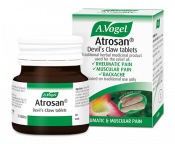What is the best way to relieve neck and shoulder pain?
Whether it's to do with your occupation or tension in the area, neck and shoulder pain are super common occurrences. To deal with each problem, here is my advice:
- Sit square at your desk or steering wheel
- Use one pillow at night
- Stretch your neck and shoulders
- Strengthen your neck
- Strengthen your shoulder muscles
- Apply some arnica gel for quick, localised pain relief
- See a cranial osteopath if you're over 40
- Change your diet
- Address the stress
- Keep your neck warm
Read on to find out more about why these things are helpful.
Why is neck and shoulder pain such a problem?
Is your posture hunched, bent at the middle or leaning slightly to one side? Far too many of us these days suffer from shoulder and neck pain, so maybe we should have listened to our parents and teachers when they told us to "SIT UP STRAIGHT!" and stop slouching...
We have become a nation of 'slumpers', with many of us spending hours hunched in front of computers for work. Plus, in our leisure time, more often than not we are bent over our smartphones or slouched on the couch in front of the TV.
So, it is no wonder our poor shoulders and necks have started to complain! The combination of this slouchy behaviour with factors such as sleeping awkwardly, muscle strain, stress, age and overexertion puts added pressure on our necks and shoulders.
My tips to relieve neck and shoulder pain
Gone are the days when we used to walk around with books on our heads, but there are some easy ways to sort out our posture, help relieve neck and shoulder pain, speed up recovery time and even stop aches and stiffness from reoccurring.
1. Sit square at your desk or steering wheel
Slide your bottom into the back of the chair (which should be tucked in). Make sure your screen is at eye level and your keyboard or steering wheel is sitting close. Putting a rolled-up towel behind the small of your back can help you to sit straighter.
2. Use one pillow at night
Use just one at night – any more than this and you end up sleeping with your head at an unnatural angle. Try not to sleep on your front for the same reason. You can look at my article on good sleeping positions for achy muscles and joints.
3. Stretch your neck and shoulders
Tilt your head to one side and at the same time drop the opposite shoulder. Hold this stretch for 30 seconds, making sure the stretch doesn't hurt but just using the weight of your head to ease out tension. Repeat on the other side. Next, look squarely over one shoulder then the other. Hold for 30 seconds on each side.
4. Strengthen your neck
While lying on your back, put your tongue to the roof of your mouth and move your chin towards your chest while keeping the back of your head on the floor. Hold for 5 seconds and then lift your head up and forwards and hold for another 5 seconds. Imagine you're doing this bit while bending from the part of the spine behind the ears. These exercises counter the effects of a body slumped forwards with the head craned up to a screen.
5. Strengthen shoulder muscles
A lot of neck pain is caused by deconditioned muscles between the shoulder blades. Strengthen them by squeezing your shoulder blades together whilst standing, so your shoulders are pulled backward. Hold for a count of 5 each time and repeat for one minute initially.
6. Apply some arnica gel for quick, localised pain relief
If you're already taking any pain medicines, arnica gel won't clash with them but it could mean you don't have to step up to stronger ones with all their side effects. A great quick fix while you're following all the other tips included here!
My Top Tip:

Apply 2-10 cm of Atrogel Arnica gel to the affected area. Use between 2-4 times daily.
"Very impressed with the arnica gel."

7. See a cranial osteopath if you’re over 40
You'll need to be sure that your neck pain isn't caused by a slight curvature of the spine (called scoliosis) which nearly everyone develops in time. Older adults should also see a specialist before trying any exercises as something called cervical stenosis can often develop (the same as the lumbar stenosis that causes older adults to bend forward for relief from the pain, but in a more vulnerable area).
8. Change your diet
Plant foods are full of magnesium that helps relax tense muscles. Tea by the gallon stops the absorption of this nutrient so you may want to limit your intake. Also, Chinese meals commonly contain MSG, a known excitotoxin to the nervous system. Excitotoxins, which include the sweetener aspartame, are also known to increase pain perception.
9. Address the stress
Stress creates a situation called 'tetany'. Tetany means tight muscles and the neck and shoulders are very commonly affected. Try a stress-easing remedy, perhaps one containing valerian to help both the stress and the tension. Remedies containing valerian are also very helpful if the pain affects your sleep.
10. Keep your neck warm
Wear a scarf, have warm showers, use heat pads and hot water bottles regularly. This encourages the muscles to relax and pain to lessen.
Originally published 11 March 2015 (updated 18 November 2020)





 Looking for a treatment to relieve pain in conditions such as muscle aches or pains, stiffness, rheumatic pain or after sporting injuries?
Looking for a treatment to relieve pain in conditions such as muscle aches or pains, stiffness, rheumatic pain or after sporting injuries?

